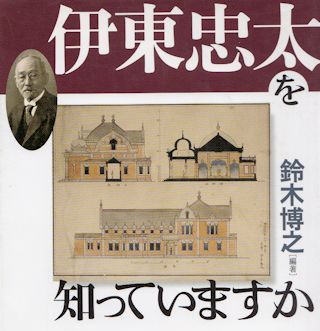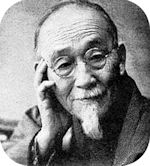|
Midori Yamabe stops memo-writing and speaks hesitantly about the documents
sent to Suga just after his request to cooperate.
Suga answers smiling.
"Thanks a lot. Particularly this book was very helpful to know Dr.
Itoh."
The title is "Do You Know Chuta Itoh?" edited by Hiroyuki Suzuki, published by Oukoku Company in 2003.

Tsubune reads the introduction part of Dr. Itoh for Suga.
 Chuta Itoh is known as an architect designed such unique figurative buildings
as Tsukiji-honganji Temple and the Earthquake Memorial Hall (presently
Metropolitan Memorial Hall). Chuta Itoh is known as an architect designed such unique figurative buildings
as Tsukiji-honganji Temple and the Earthquake Memorial Hall (presently
Metropolitan Memorial Hall). |
| In his graduation thesis Chuta Itoh applied a new theory to the architecture
of Horyuji Temple, which is, according to him, deeply related to the architectural
style in the Ancient Greece |
| In Meiji 35 (1902), he rejected the study in the Western countries which was the way to a professor. On the other hand, he planned the overseas travel on his own, and toured from China through Burma, India, the Mideast and Small Asia, Europe, and finally returned to Japan from the U.S. after three and a half years. It was an unprecedented great architectural journey in those days. |
| Moreover, Chuta Itoh systemized the study of architectural history for
the first time in Japan, and created this study of presently traditional
dignity at Tokyo Imperial University and Waseda University. |
| There are many buildings designed by Dr. Itoh. The following are his main works. |
Heian Shrine, Taiwan Shrine, Korean Shrine, Houkoku Mausoleum, Kasuisai-gokoku
Tower, Shinshu-shinto Life Insurance, Yahiko Shrine, Genko-semmetsu Monument,
Uesugi Shrine, Kanematsu Auditorium, Gion-kaku, Kyoto Mansion of Kihachiro
Ohkura, Ohkura-shukokan Hall, Yushukan Hall of Yasukuni Shrine, Tsukiji-honganji
Temple, Great Earthquake Memorial Hall, Shogyoden Hall of Hokekyoji Temple,
God Gate of Yasukuni Shrine, Yushima Sanctuary, Meiji Shrine, Myozenji
Temple, .....
|
He is a member of the Imperial Japan Academy.
He was awarded the Order of Culture in 1943 for the first time in the world
of architectural study. |
The elderly senior is listening to Tsubune's reading and ruminating on
the character of the giant in the architectural world with his eyes closed.
Pondering over the article himself while the junior is reading through,
he opens his mouth after a moment.
"It is our pride that Kanematsu Auditorium is the masterpiece Chuta
Itoh praises himself. Therefore, I am all the more concerned about the
numerous monsters inside and outside of the auditorium. They make me feel
his spirit and also his outstanding intention."
The elderly raises his tone of voice a little.
"When we looked around its inside in detail from the second floor
down to the basement, I never had such impression as this auditorium was
built only under Dr. Itoh's monster hobby. Your fax says the same thing
too."
Suga makes sure of Tubune's agreement and continues his talk.
"Dr. Itoh reports at the ceremony commemorating its completion that
he took his real intention out on this auditorium which should not only
have solemn atmosphere as much as possible but also maintain the true value
as an auditorium. The monsters on parade and the solemn atmosphere will
perhaps be matched together finally, but besides, I feel some implied meanings
of Dr. Itoh."
The reality around Suga may be lack of information for his desire to know
more. Though looks mild on his face, his talk seems frustrating with discontent.
"My experience of nearly seventy years since the entrance to the college
is not so helpful, and the documents, in spite of a big volume including
Yamabe-san's, only clear obstacles in advance, far from the core.
Suga changes the topic a little bit.
"The reconstruction work of the auditorium completed this spring was
done by Mitsubishi Jisho Sekkei Inc. If its staffs would meet us, it would
help us have more clues."
"Agreed, but how?"
Answering Tsubune's question,
"I have a connection with Mr. Kitani, a general manager. I will contact
him. And..., another clue may be the route to Eiichi Shibusawa. I would
like to look into him much more."
Shibusawa is the father and the foster parent of this school. He went on
supporting its subsistence and development until his death. There might
be something to have overlooked, so Suga would like to visit Shibusawa
Memorial Museum and to check the whole documents of Shibusawa's footprints
soon too.
"What about Mr. Kawaji's article?"
Mutsumi Iwaida still sticks to his inference. The elderly senior puts the
hand on his bald head only pretending, and says.
"I honor his zeal and behavior all right, but I would like to have
an investigation in my way for a while."
It has been quite dark. Every table is in full swing with a barbecue party.
-----
Several days later, in the early morning, Tsubune was made awake by a phone
call from Suga.
Suga: "Sorry, too early. Aren't you still in bed?"
Tsubune: "Don't worry, sir. Anything special?"
Suga: "I found an interesting document at the back of the bookshelf."
Tsubune: "What is it?"
Suga says, "It is about the time when the alumni of the boat club
named their group as "Shishin-kai" (Four God Group)."
Then,
Suga: "I assumed its time to be Showa 2 (1927), because it was the
year Kanematsu Auditorium with Four-God Statues on the facade was completed,
and by chance or not, the memorial events related to Shishin-kai began
that year as far as I know. But it was my mistake."
Tsubune: "???"
Suga: "Tormenting the history is not allowed, but honestly in order
to explain the four relieved badges on the facade as 'Four-God Statues',
the group name Shishin-kai of the boat club alumni should have been before
the construction of Kanematsu Auditorium, and I wanted to consider the
concept of Shishin (Four Gods) had already taken root as a banner of the
school, not only of the boat club. I firmly believed that not only Mercury
was the school's symbol but also what we call Four-God Statues including
Mercury had already been the symbol of our school."
Tsubune, even with sleepy eyes, seems to understand finally what Suga is
talking about.
The voice from the phone is trying to be slow and steady so as to be more
understandable.
"And, what did you find, sir?", Tsubune asks the senior expectantly.
Suga: "The old document taught me that I might have possibly made
misunderstunding. It reads the start of Shishin-kai was Taisho 8 (1919),
seven years before my preconception of Showa 2 (1927) when Kanematsu Auditorium
was built. This article is the evidence."
Tsubune: "Good for you, sir."
The junior understands what the senior is going to talk about.
Suga: "It's rather embarrassing, but I feel I have got over one hurdle
now. My prejudice was probably not altogether a delusion."
Suga seems to have made sure that Shishin-kai (Four God Group) was at least
involved in the production of the Shishin (Four Gods) statues on the facade.
"One more thing, ..." continues the senior's long phone talk.
Suga: "Concerning Mr. Sano, he doubled as Manager of the boat club
when he became the president of Tokyo Commercial College (TCC), though
he had not been an oarsman during the student days."
Tsubune: "Is that right!"
Contrary to Tsubune's reaction, the senior has already known it. He also
knew Mr. Sano was close to the alumni's Shishin-kai (Four-God Group) as
a manager of the boat club and the president of TCC at the time of the
auditorium construction.
However, Suga has not cared the link with the Four-God statues on the facade
yet. So, he adds.
"We are still not on the stage where we can connect various patches
here and there hastily, but the important thing is Mr. Sano who we think
debated with Chuta Itoh as the president of TCC was with the school from
the start, served as Manager of the boat club and had a close relationship
with Shishin-kai."
Tsubune: "The identity of the monsters has appeared a little to your
eyes, hasn't it?"
Suga: "I feel like I had a weight lifted off my chest just a little
bit. After I checked the document late last night, I could not sleep. I
couldn't stand calling you up. Well ..., good night."
The morning sun is beginning to beam into the curtain. Tsubune decided
to wash his face, smiling wryly.
|